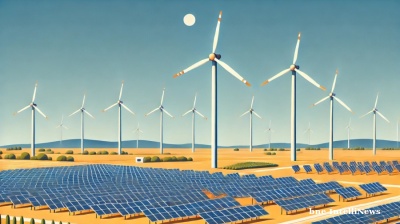The cost of electricity generated from solar photovoltaic (PV) panels has plummeted in recent decades, driven by supportive government policies and technological advances, and the energy source is expected to overtake coal in 2025 in terms of its share of the global energy mix, the International Energy Agency (IEA) said on September 23.
The global capacity for solar PV has expanded at an unprecedented rate, tripling between 2018 and 2023, led by China, which has emerged as a global green energy champion. Two thirds of all installed solar power capacity is currently in China.
The surge in solar is reshaping the global energy landscape, with renewable energy sources such as solar PV, wind and hydro expected to generate more electricity than coal as early as 2024. If realised, it will mark the first time in history that renewables will have overtaken the world’s most carbon-intensive energy source.
As bne IntelliNews reported, China’s wind and solar renewables have already overtaken coal in its national energy mix and the country is believed to have already reached peak emissions well ahead of the rest of the world. Other regions like Central Asia and the Balkans are still a long way behind, heavily relying on coal for power.
Alongside hydro and wind power, solar energy is rapidly becoming a dominant player in the transition towards greener energy. "Renewables are set to generate more electricity than coal next year. That would be a first," according to the IEA.
China leads with over 609 GW of installed capacity, accounting for the largest share globally, followed by the US and Japan. Solar power is expanding rapidly, with countries like Germany and Italy achieving higher shares of solar generation in their electricity mix, while others, such as Canada and the UK, are growing more gradually. India is also emerging as a key player with significant growth in solar capacity.
China’s massive investments in solar PV manufacturing have played a crucial role in driving down global costs. By capitalising on economies of scale, Chinese manufacturers have achieved significant cost reductions, spurring the widespread adoption of solar technology. However, this dominance has led to highly concentrated manufacturing supply chains, raising concerns about an over-reliance on a single market.
"Greater diversity will be important as the rollout of solar power accelerates," the IEA warns, stressing the need to expand solar manufacturing capabilities beyond China to enhance global energy security and resilience.
|
Solar energy share, capacity in selected countries |
||
|
Country |
Solar Share of Electricity (%) |
Installed Solar Capacity (GW) |
|
China |
5.7% |
609 GW |
|
India |
5.8% |
70 GW |
|
United States |
5.5% |
153 GW |
|
Germany |
10.3% |
73 GW |
|
United Kingdom |
5.1% |
14 GW |
|
France |
4.3% |
16 GW |
|
Japan |
8.7% |
82 GW |
|
Italy |
9.5% |
25 GW |
|
Canada |
1.2% |
5 GW |
|
Source: IEA |
||



bneGREEN

Kyrgyzstan says neighbours “upset” by country’s lack of water
“This year we were supposed to overcome shortages, but instead, they have intensified,” deputy head of cabinet tells Uzbekistan and Kazakhstan.

EXPLAINER: What is the EU’s CBAM and how will it affect global trade from 2026?
The European Union’s Carbon Border Adjustment Mechanism (CBAM) will enter its full operational phase on January 1, 2026, marking a major shift in global climate and trade policy.

Iran faces critical water crisis after driest year in five decades
Iran faces critical water crisis after driest year in five decades with 40% nationwide rainfall drop.

Global renewables to double by 2030, but IEA warns momentum must accelerate
Global renewable energy capacity is on course to double by 2030, reaching 4,600 GW—comparable to the current combined total of China, the European Union and Japan—according to the International Energy Agency’s Renewables 2025 report.


_2_1761012864.jpg)

